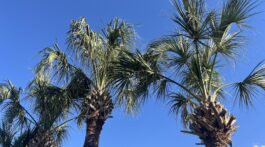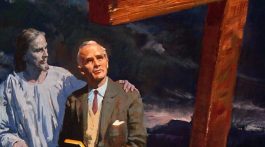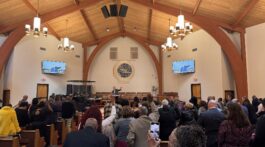As I write this article, I am doing a series of meetings deep in Maasai territory in Kenya. When it was first suggested that the Minnesota Conference participate in a mission emphasis in the Kenya, I was a little hesitant because the Adventist Church is stronger in Kenya than just about anywhere else in the world. Having worked for Global Mission for many years, it’s in my blood that we badly need to concentrate on the many non-Christian people groups that remain largely untouched by the gospel. Therefore, when I agreed to travel to Kenya, I asked to work among an unreached group. So I was assigned to the Maasai tribe.

There are some Massai who are Seventh-day Adventists, and even some who are elders and pastors. But not many. The Maasai cling tightly to their traditions and their peaceful rural lifestyle, and they are not easily convinced to enter the flow of mainstream Kenyan trends that conflict with their culture, including Christianity.
I had no idea how I should approach a series of meetings among the Maasai, and when I asked for advice from other Kenyans they didn’t really know either. They assumed I would do a traditional evangelistic series. But if the people are mostly biblically illiterate, I reasoned, using a standard Adventist evangelistic series just didn’t make sense. Perhaps, I thought to myself, just telling stories would be the best way to begin.
When I finally arrived in Maasai Land, as it is called, I finally found the opportunity to talk to some Maasai Seventh-day Adventists. I asked their advice for what they thought I should present, and they too shrugged, assuming I would do a standard evangelistic series. When I floated the idea of just telling Bible stories, suddenly I observed a light flicker in their eyes. “Yes,” they said enthusiastically, “we like that idea!” We talked it through in more depth and decided that this evangelistic series would be the story of redemption from beginning to end, presented not as thematic theological sermons, but simply as stories. True stories from the Bible.
The first night of the meetings I was driven up into the hills around the city of Kilgoris in western Kenya. The village is called Oldonyo Rasha. The road to the site where I am preaching is more of a footpath, and the scene at the top of the mountain is idyllic. Unlike the city at the base of the mountain, which is dirty and crowded, the mountaintop is kept in pristine condition as the Maasai live in close relationship with the nature they love. Their neatly-built mud or concrete homes are roofed with tin or grass in the traditional style. Their animals are kept in pastures of intricately woven wood, plants, and briars to keep them safe from predators.
To welcome my arrival, the brightly-dressed group escorted me to the site with a choreographed march and singing. They “covered” me with a shukah (the traditional Maasai blanket) and gave me a Maasai name that means rain. Then we walked across to the opposite hill where they hope one day to construct a church. There as the sun set, they gave me an olive tree seedling, which I planted to mark the event.
The next night I started the meetings telling the story of when sin entered heaven, and then night by night I worked through the highlights of the Old Testament stories: creation, flood, Babel, Abraham, and so on. A week into the meetings, which was halfway through the two-week series, I started telling stories of Jesus. By that time the feeling at the meetings had changed. My newness as a muzungu (white man) had worn off, and everyone had settled into something of a routine and a sense of normality.
Last night, after I finished preaching, we sat as usual in the home of our host along with several others, drinking soy milk or tea and munching on small, sweet bananas. My associate speaker, a Maasai pastor who had traveled from his home in Maasai Mara to be a part of these meetings, sat with us as well. As we talked together, he told me and the others how he worked for seven years before he finally managed to baptize three of his people. “All three were women, and two of them were widows,” he said. “The Maasai do not abandon their traditional ways easily.”
“However,” he continued, “I don’t know if you recognize it or not, but what you are doing is different and it’s working.” Naturally I asked him to explain, and he replied, “People are understanding and following the stories more than they follow more abstract sermons. And people beyond the group you can see in front of you are also listening.” (Public meetings in Kenya always blast their generator-powered sound systems incredibly loud. At first this irked me, but now I think I’m beginning to see why they do it. They are projecting out to those who do not come and sit in front of the speaker.)
“So what makes you think the stories are making an impact,” I pressed. He replied, “Because we are traveling around visiting people in their homes, and they are asking questions. They say, ‘The muzungu said such and such, and we want some more explanation.’ That,” he said, “is giving us the opportunity to go deeper into our spiritual conversations with them. They are engaging with the stories even outside of the meetings. So continue telling stories. People are listening.”
By now, I think I have been sold on this method of conducting evangelistic meetings by telling the story of redemption. And not only for unreached groups, but maybe for everyone. After all, stories make up most of the Bible, and Jesus relied heavily on stories. So there must be something good about it.

Kenya Mission Trip Highlights
When the Minnesota mission group of about 46 volunteers arrived in Kenya, we met at the union office in Nairobi and boarded a bus for the seven-hour trip through the Great Rift Valley to the western side of the country. Our group split into three smaller groups, one working around the city of Kisii, another group working around the city of Kilgoris, and another working around the city of Lolgorien.

Our Minnesota group was joined by 50 or so local Adventists, many of them medical professionals, who operated four different medical camps. These camps were set up in churches, tents, and even tarp-covered wigwam-like shelters, and they served more than 2,600 people who came for treatment. Additionally, we partnered with the Lions Club to run an eye clinic in several locations, even offering cataract surgery onsite in two locations. The eye clinic teams treated more than 1,400 patients and performed more than 100 eye surgeries. We also helped build a school; assisted in an orphanage and schools; distributed Bibles, hygiene products, food, clothing, and household items; and planted a new branch Sabbath School. Now we are sponsoring 10 Bible workers who will follow up with new believers—all made possible by faith-filled donations from Minnesota church members.

Minnesota provided preachers for 18 different sites, most of them in marketplaces or near busy roads with a lot of foot traffic. Public address systems ensured that the messages were carried far and wide. When they were not speaking, our Minnesota missionaries teamed up with local pastors to visit attendees in their homes. Because local Adventists had already been witnessing and teaching others before our arrival, we were blessed to baptize about 900 people during the meetings, most of them in narrow, muddy creeks that had been dammed up to create small pools. The baptisms included two of our young missionaries from Minnesota who dedicated their lives to Christ along with their African brothers and sisters.
In appreciation for our work, the local government gave our whole group free admission to the Maasai Mara game park, which, for foreigners, usually costs $200/person at this time of year. Many Minnesotans were thrilled to spot their first elephants, zebras, giraffes, and other wild animals.
Please pray as our church members in Kenya continue to disciple new believers. Pray also that the enthusiasm gained on this short-term mission trip will inspire Minnesota believers to spread the good news here at home.
Jeff Scoggins is the president of the Minnesota Conference.







